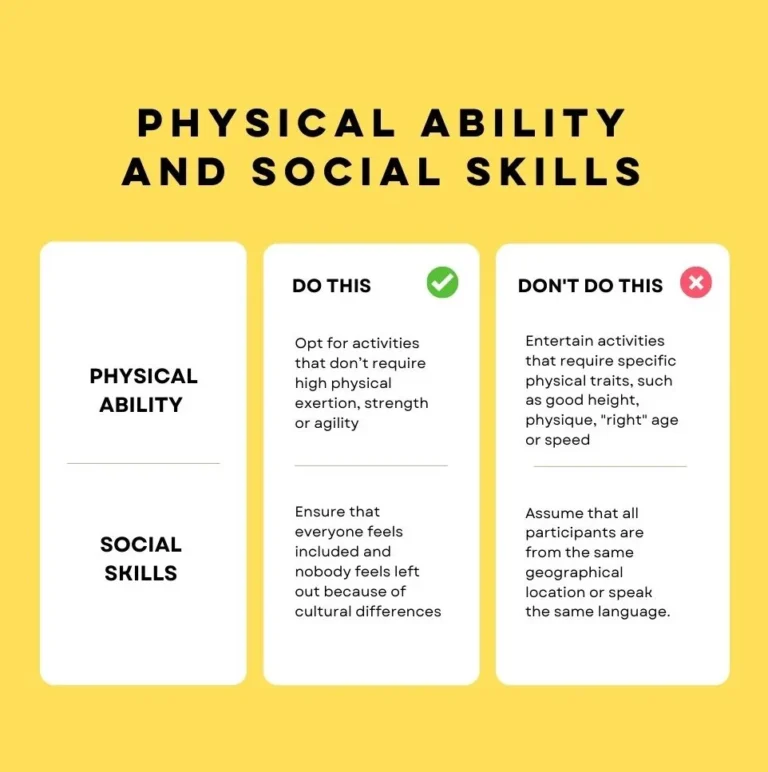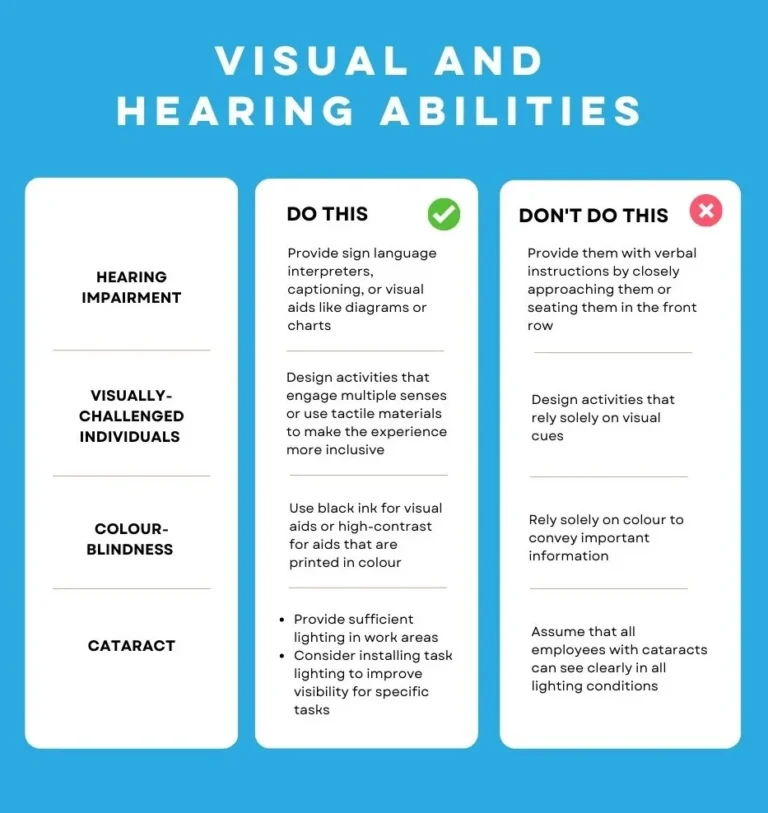Team building Activities:
Common Mistakes and How to Avoid Them!

Discover the art of hosting wholesome team building activities by setting and living up to crystal-clear expectations, embracing inclusivity for all abilities, and satisfying all kinds of dietary desires. With our practical tips, you’ll orchestrate an unforgettable team bonding experience that fosters collaboration, growth, and endless laughter. Say goodbye to mishaps and hello to a united, unstoppable workforce!
#1 Pushing Personal Boundaries

The Problem:
Lack of personal space
While a Twister game or tug-of-war may be your go-to for team building activities, it’s important to keep in mind that not everyone is a fan of “up-close-and-personal”. After all, nothing kills team spirit faster than making people feel uncomfortable and violating their personal space. So, let’s ensure that everyone’s boundaries are respected, or we’ll end up with a team that’s more disjointed than a puzzle with missing pieces!
The Solution:
- Get your Mind in the Game: Why limit yourself to just physical activities when there are plenty of mentally stimulating options available? It would be a good idea to maintain a variety of activities that don’t require physical touch. Include problem-solving games, brainstorming sessions, or games that encourage verbal communication in your team-bonding fun!
- Finding the right Balance: If outdoor physical activities are preferred by some, you can always find a middle ground by hosting team bonding activities such as team sports, nature walks, party games or relay races. Whatever activities are chosen, it’s important to ensure that they are inclusive and enjoyable for everyone involved.
- Beyond the Bubble: Hear us out! Pushing people slightly out of their comfort zone, though, we agree, it may seem invasive, could be beneficial for personal growth and development! But it’s important to strike a balance and not go too far. A way to do this would be to foster a collaborative and supportive team culture where team members can learn from each other’s strengths and weaknesses, build stronger relationships, and develop the emotional resilience needed to navigate through challenging situations.
#2 Ignoring Weather Woes

The Problem:
Imagining that it is always going to be bright and sunny
The goal is to leave the team with a pleasant experience. So, don’t let Mother Nature rain on your parade or scorch your team’s dreams as a collective!
The Solution:
- Foresee your Forecast: You must always check the weather forecast and plan accordingly to avoid any inconvenience.
1. Choose a day with moderate weather conditions that will enable everyone to participate comfortably.
2. Steer clear of extreme weather conditions and hence, you can avoid turning your fun group activity into a survival expedition!
- Prepare for failures: Identify if the activity can be shifted indoors if required.
It is important to have a contingency plan in case of unexpected weather, safety concerns, double bookings or even venue issues – one way to prepare for this is to identify beforehand whether the activity can be shifted indoors if needed.
#3 Not Setting the Right Expectations

The Problem:
Refusing to learn from past mistakes
Team leaders from business units of an organisation sometimes see team-building activities as frivolous with no real impact on results and revenue. This might be because of setting certain expectations and activity mismatch.
Sometimes, in the past, employers or managers may have invited your team to a ‘super immersive fun afternoon with loads of memories’ that might just be a classroom training where people have to take rigorous notes.. and the only memory is of disappointment and a little bit of anger.
Fun vs. Learning Fiasco
When organising a team building activity, it is important to clearly outline the ultimate outcome in the brief. This includes identifying the specific traits or skills that the team needs to improve upon or develop, such as better communication, taking initiative, or articulating ideas more effectively. Now, to make sure that the facilitators and employees are on the same page, have a quick discussion about keeping the team culture intact and what the team managers would like to tackle. What traits do you want them to embody? And what needs to get kicked to the curb? At the same time, you can’t forget about the things they’re already great at – let’s make sure those continue to shine.
The Solution:
Go through this checklist to avoid the same
- Tell facilitators of the activity about your fun to learning ratio.
(Is it just a 100% fun team-building activity or do you want 50% of the focus to be on attributes teams have to improve on) - Give facilitators a good brief of your expectations and what would peg this as a success.
- Ask for activities that address your concerns like time management, energy efficiency, communication etc.
- Communicate the same to all stakeholders so that everyone is on the same page.
- Follow up activities with a de-brief addressing behaviour patterns and how to implement key learnings in their professional and personal lives.
- Ask team members to vote for the kind of activities that they want
In a world of choice and instant gratification, this is necessary sometimes.
Encourage your team to email you any apprehensions they may have, and as the decision-maker, it is essential to take prompt action in response to such concerns.
#4 Non-inclusivity faux pas
Everyone talks about Diversity and Inclusion these days, but, inclusivity in team building is very often overlooked, yet it’s crucial for creating a positive and productive work environment. When planning team building activities, it’s important to consider all kinds of abilities, constraints and states of being –
Physical abilities and social skills
People can be diverse in their physical abilities, ranging from differently-abled individuals to varying levels of mobility and constraints, making it crucial to consider and accommodate everyone while hosting team building activities for employees.

Neurodiversity
When planning team building activities that rely heavily on social cues or that may trigger undue discomfort, it is important to pay close attention to the individual needs of neurodiverse individuals. For example;

Visual and hearing abilities
The key to facilitating the participation of individuals with visual or hearing impairments is to prioritize accessibility, communication, and inclusion. By considering their specific needs and implementing appropriate strategies, you can create a more inclusive and engaging team building experience for everyone involved.

Injuries and health conditions
Some team members may also have chronic injuries or conditions that limit their physical abilities. When planning team building activities, it’s important to be mindful of any activities that could exacerbate these issues and offer alternative options or modifications to ensure everyone can participate safely.

At Indian Shades, we believe that inclusivity in team building activities will foster a culture of respect and understanding within the team – and this is reflected through our many offerings, where participants can learn to appreciate and respect each other’s differences, leading to greater empathy and acceptance!
#5 All’s fair in Love and War
(but not Food and Beverages)
To create an inclusive and also a welcoming environment for your team, it is crucial to consider their dietary needs and preferences. Neglecting this consideration can lead to various drawbacks and challenges, including feeling of exclusion and discomfort, decreased productivity, reduced team morale and limiting diversity and collaboration.

Bonus Tips!
If you made it till the end – congratulations! We’re gifting you with some bonus tips:
- Itinerary: Give your team members a road map: It is a great way to get everyone excited about the adventure ahead!
- Timing: It is essential to consider the timing of your team building activities – not everyone is a morning person or a night owl. Be sure to meet each other halfway.
- Permissions: Whether you’re planning a team building activity in-house or at an external venue, it is important to ensure that you have the necessary permissions and clearances in place.
- First aid: It’s always better to be safe than sorry. So, make sure that you have a list of emergency numbers in handy – whether it’s a medical emergency or a logistical issue.
- Run simulations: Sometimes, it’s a good idea to run simulations of the team building activity beforehand, especially if it’s a new or complex activity. This can help you identify any potential issues or bottlenecks.
- Free from rallies: Nothing must stop you and your team from having the time of your life – not even a political or a social issue. Ensure that your team building activity location is free from civilian unrest and rallies!










